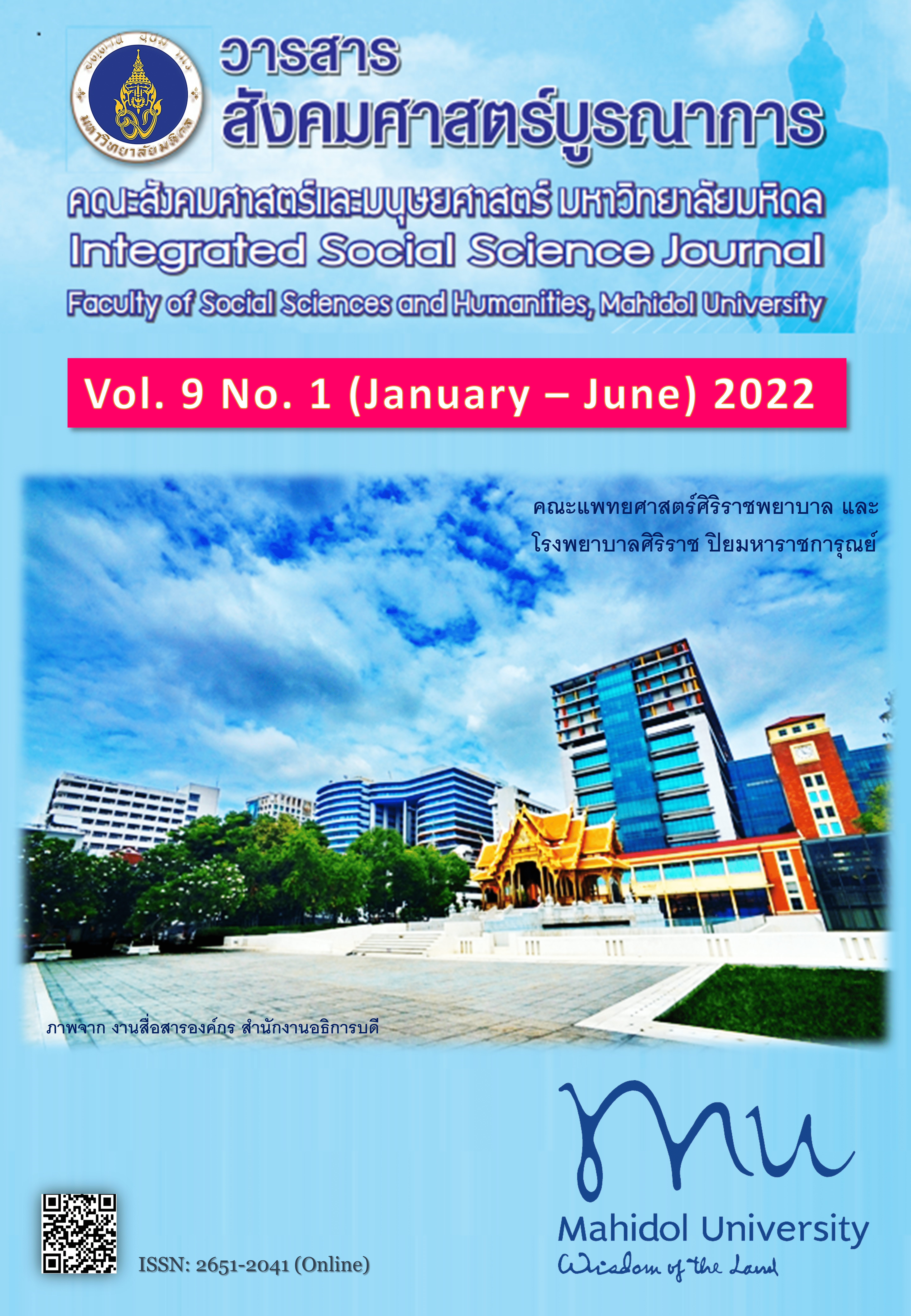ความแปรเปลี่ยนของกระบวนทัศน์ทางรัฐประศาสนศาสตร์ที่มีอิทธิพลต่อแนวปฏิบัติและองค์ความรู้ด้านการบริหารทรัพยากรมนุษย์ในภาครัฐ
Main Article Content
บทคัดย่อ
บทความวิชาการนี้มีวัตถุประสงค์เพื่อนำเสนอองค์ความรู้และแนวปฏิบัติด้านการบริหารทรัพยากรมนุษย์ภาครัฐ ที่แปรเปลี่ยนไปตามบริบทของสังคมโลก และตามกระบวนทัศน์ทางรัฐประศาสนศาสตร์ ผู้เขียนใช้วิธีการวิเคราะห์เชิงเนื้อหาจากหลักฐานทางวิชาการและการวิจัย และพบว่า องค์ความรู้ทางด้านรัฐประศาสนศาสตร์ และ การเปลี่ยนแปลงของบริบทโลก มีอิทธิพลต่อแนวปฏิบัติและองค์ความรู้ทางด้านการบริหารทรัพยากรมนุษย์ในภาครัฐเป็นอย่างมาก โดยแนวปฏิบัติและองค์ความรู้ด้านการบริหารทรัพยากรมนุษย์ในภาครัฐที่เปลี่ยนแปลงไป สามารถแบ่งออกได้เป็น 2 มุมมอง ได้แก่ มุมมองด้านการบริหารทรัพยากรมนุษย์แบบดั้งเดิม และ มุมมองด้านการบริหารทรัพยากรมนุษย์แบบร่วมสมัย และด้วยกระแสโลกาภิวัตน์ ระบบทุนนิยม และการเปลี่ยนแปลงอย่างฉับพลันในด้านต่าง ๆ ผู้เขียนเสนอให้องค์การภาครัฐยุคใหม่ ควรให้ความสำคัญกับ “การเน้นคนเป็นศูนย์กลาง” เนื่องจากข้าราชการและพนักงานของรัฐเหล่านี้ถือเป็น “ทุนมนุษย์” ที่สามารถ “สร้างมูลค่าเพิ่ม” ให้แก่องค์การได้ และหัวใจสำคัญ คือ การประยุกต์ใช้กระบวนการรจัดการทุนมนุษย์เชิงกลยุทธ์ เพื่อสร้างความได้เปรียบในการแข่งขันที่ยั่งยืนให้แก่องค์การภาครัฐต่อไป
Article Details

อนุญาตภายใต้เงื่อนไข Creative Commons Attribution-NonCommercial-NoDerivatives 4.0 International License.
- วารสารสังคมศาสตร์บูรณาการ มหาวิทยาลัยมหิดล อนุญาตให้สามารถนำไฟล์บทความไปใช้ประโยชน์และเผยแพร่ต่อได้ โดยอยู่ภายใต้เงื่อนไขสัญญาอนุญาต CC Attribution-NonCommercial-NoDerivatives 4.0 International (CC BY-NC-ND 4.0) โดยต้องแสดงที่มา/การอ้างอิงจากวารสาร – ไม่ใช้เพื่อการค้า – ห้ามแก้ไขดัดแปลงเนื้อหา
- ข้อความที่ปรากฏในบทความในวารสารฯ เป็นความคิดเห็นส่วนตัวของผู้เขียนแต่ละท่าน ไม่เกี่ยวข้องกับกองบรรณาธิการวารสารฯ (ซึ่งหมายรวมถึง บรรณาธิการ ผู้ทรงคุณวุฒิในกองบรรณาธิการ หรือ บรรณาธิการรับเชิญ) แต่อย่างใด ความรับผิดชอบองค์ประกอบทั้งหมดของบทความแต่ละเรื่องเป็นของผู้เขียนแต่ละท่าน หากมีความผิดพลาดใด ๆ ผู้เขียนแต่ละท่านจะรับผิดชอบบทความของตนเอง ตลอดจนความรับผิดชอบด้านเนื้อหาและการตรวจร่างบทความเป็นของผู้เขียน ไม่เกี่ยวข้องกับกองบรรณาธิการวารสารฯ
- กองบรรณาธิการขอสงวนสิทธิ์ในการตัดทอน/ปรับแก้ถ้อยคำบางประการเพื่อความเหมาะสม
เอกสารอ้างอิง
นิศาชล รัตนมณี และ สันติธร ภูริภักดี. (2560). แนวทางการจัดการสมัยใหม่ที่มีผลต่อการดำเนินงาน: กรณีศึกษาบริษัท ช ทวี จำกัด (มหาชน). วารสารวิชาการ เทคโนโลยี พลังงานและสิ่งแวดล้อม บัณฑิตวิทยาลัย วิทยาลัยเทคโนโลยีสยาม, 4(2), 28-36.
สำนักงานพัฒนาวิทยาศาสตร์และเทคโนโลยีแห่งชาติ (สวทช.). (2560). พิมพ์เขียว Thailand 4.0. https://www.nstda.or.th/home/knowledge_post/blueprint-thailand-4/
สำนักงานคณะกรรมการข้าราชการพลเรือน. (2549). คู่มือการประเมินสถานภาพการบริหารทรัพยากรบุคคลของส่วนราชการ: รูปแบบ วิธีการและเครื่องมือ. สวิชาญการพิมพ์.
Armstrong, M. (2006). A handbook of human resource management practice. Kogan Page.
Barnard, C. I. (1938). The functions of the executive. Harvard University Press.
Barney, J. B. (1991). Firm resources and sustainable competitive advantage. Journal of Management, 17(1), 99–120.
Boon, C., Eckardt, R., Lepak, D. P., & Boselie, P. (2018). Integrating strategic human capital and strategic human resource management. The International Journal of Human Resource Management, 29(1), 34–67. https://doi.org/10.1080/09585192.2017.1380063
Delery, J. E., & Roumpi, D. (2017). Strategic human resource management, human capital, and competitive advantage: Is the field going in circles? SHRM and HC: is the field going in circles? Human Resource Management Journal, 27(1), 1–21. https://doi.org/10.1111/1748-8583.12137
Denhardt, R. B. (2014). Theories of public organization (7th ed). Cengage Learning.
Diefenbach, T. (2009). New public management in public sector organizations: The dark sides of managerialistic ‘enlightenment.’ Public Administration, 87(4), 892–909. https://doi.org/10.1111/j.1467-9299.2009.01766.x
Do, T. T., & Mai, N. K. (2020). A systematic review on high performance organization. Management Research Review, 44(1), 181–208. https://doi.org/10.1108/MRR-11-2019-0495
Dooren, W. van, Bouckaert, G., & Halligan, J. (2015). Performance management in the public sector (2nd ed.). Routledge.
Drucker, P. F. (1954). The practice of management. Harper & Brothers.
Fiedler, F. E. (1978). The contingency model and the dynamics of the leadership process. In L. Berkowitz (Ed.), Advances in experimental social psychology (Vol. 11, pp. 59–112). Academic Press.
Fox, E. M. (1968). Mary Parker Follett: The enduring contribution. Public Administration Review, 28(6), 520–529. https://doi.org/10.2307/973329
Harney, B., & Collings, D. G. (2021). Navigating the shifting landscapes of HRM. Human Resource Management Review, 31(4), 100824. https://doi.org/10.1016/j.hrmr.2021.100824
Henry, N. (2010). Public administration and public affair. Prentice Hall.
Huselid, M. A., Jackson, S. E., & Schuler, R. S. (1997). Technical and strategic human resource management effectiveness as determinants of firm performance. Academy of Management Journal, 40(1), 171-188.
Karami, A., Analoui, F., & Cusworth, J. (2004). Strategic human resource management and resource-based approach: The evidence from the British manufacturing industry. Management Research News, 27(6), 50-68.
Locke, E. A. (1982). The ideas of Frederick W. Taylor: An evaluation. Academy of Management Review, 7(1), 14–24. https://doi.org/10.2307/257244
Lynn, L. E. (1998). The new public management: How to transform a theme into a legacy. Public Administration Review, 58(3), 231–237. https://doi.org/10.2307/976563
Maslow, A. H. (1970). Motivation and personality. Harper and Row Publisher.
O’Toole, L. J., & Meier, K. J. (2009). The human side of public organizations: Contributions to organizational performance. The American Review of Public Administration, 39(5), 499–518. https://doi.org/10.1177/0275074008323805
Obedgiu, V. (2017). Human resource management, historical perspectives, evolution, and professional development. Journal of Management Development, 36(8), 986–990. https://doi.org/10.1108/JMD-12-2016-0267
Porter, M. E. (1996). What is strategy? Harvard Business Review, 74(6), 61–78.
Powell, T. C. (2001). Competitive advantage: Logical and philosophical considerations. Strategic Management Journal, 22(9), 875–888. https://doi.org/10.1002/smj.173
Saridakis, G., Lai, Y., & Cooper, C. L. (2017). Exploring the relationship between HRM and firm performance: A meta-analysis of longitudinal studies. Human Resource Management Review, 27(1), 87–96. https://doi.org/10.1016/j.hrmr.2016.09.005
Swiss, J. E. (2005). A framework for assessing incentives in results-based management. Public Administration Review, 65(5), 592–602. https://www.jstor.org/stable/3542525
Weber, M. (2009). Bureaucracy. In H. H. Gerth & C. W. Mills (Eds.), From Max Weber: Essays in sociology (pp. 196–244). Routledge.
Wilson, W. (1887). The study of administration. Political Science Quarterly, 2(2), 197–222. https://doi.org/10.2307/2139277
Wright, B. E. (2011). Public administration as an interdisciplinary field: Assessing its relationship with the fields of law, management, and political science. Public Administration Review, 71(1), 96–101. https://doi.org/10.1111/j.1540-6210.2010.02310.x


